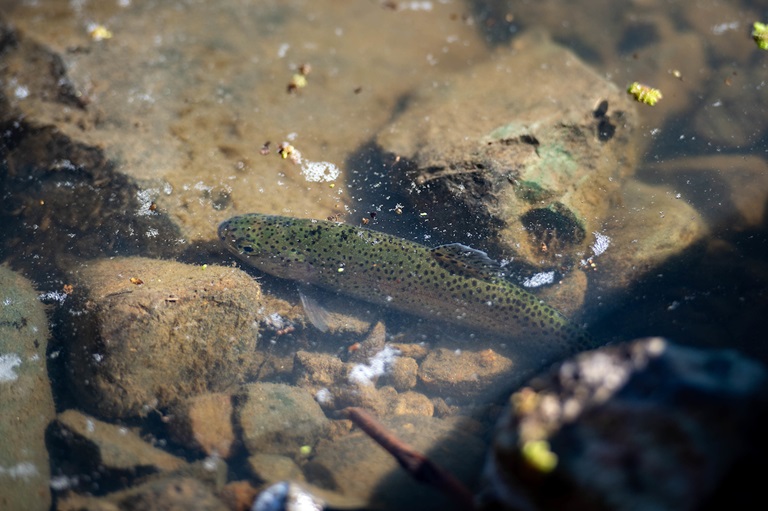State Water Project Takes Action to Protect Native Fish Species
The Feather River Fish Hatchery raises steelhead at the hatchery and releases them into the Feather River at Boyd’s Pump Boat Launch in Yuba City, California. Photo taken February 12, 2021.
Spring is an important time for water project operators to fill reservoirs ahead of dry months. It also is an important migration window for many native fish species. Steelhead trout in Central Valley rivers are listed under the U.S. Endangered Species Act as threatened. As a result, the State Water Project (SWP) and Central Valley Project (CVP) monitor steelhead at the pumping plants near Tracy that move water to the Santa Clara Valley, San Joaquin Valley, and Southern California.
The State Water Project and Central Valley Project have decreased pumping to less than half of maximum capacity since January 1 to protect migrating fish. Now, the SWP and CVP are approaching the maximum number of steelhead trout that can be collected at the pumps from December 1 through March 31 of each year under rules established by the National Marine Fisheries Service (NMFS). The water projects may reach the maximum allowable steelhead collected under those rules within the next few days. Steelhead are collected live in front of the fish screens at the SWP pumping facilities and released into Delta channels. Studies show that approximately 95 percent of the steelhead collected this way survive their journey to the ocean.
Fish monitoring stations in the Sacramento Basin have seen a significant increase in juvenile steelhead production this past year which may account for the relatively higher numbers of steelhead observed in the south Delta this winter.
The combined SWP and CVP pumping levels currently are at 3,100 cubic feet per second (cfs), well below the maximum capacity of 11,000 cfs. The California Department of Water Resources (DWR), which operates the SWP, and the U.S. Bureau of Reclamation, which operates the CVP, will consult with NMFS on steelhead protections through March 31. Importantly, DWR is also advancing the Delta Conveyance Project, which would construct new infrastructure that will make it possible to move more water during high flow events while helping these fish species avoid threats posed by current pumping infrastructure.
San Luis Reservoir, which is crucial to water supplies for much of the state’s population, is jointly operated by DWR and Reclamation. The reservoir can hold 2 million acre-feet of water. The federal portion of the reservoir, which serves largely agricultural customers whose water supply needs occur mostly later in the summer, is 99 percent full, storing 965,000 acre-feet. The state-owned portion, which serves both urban and agricultural customers, is 49 percent full, with 518,000 acre-feet. The SWP has less water stored in San Luis because it has been using more of its limited export capability under decreased pumping to send water directly to the public water districts that rely on the SWP.
These export reductions are a challenge to our water supply and DWR has been working to ensure that the best science available is guiding decisions. DWR is conducting a study of acoustic tagged steelhead to track their movements, in coordination with NMFS and Reclamation. The information from the study will help identify when the steelhead rear and migrate and allow water project operators to finetune pumping reductions. DWR also is using DNA technology to identify the origin of steelhead collected at the Delta fish screens and investing to expand steelhead habitat and monitoring.
DWR is also closely monitoring juvenile Chinook salmon collections at the fish screens relative to our regulatory limit for winter-run salmon. Using new rapid genetic testing technology and monitoring data, DWR is gathering information needed to inform future risk assessments should Chinook salmon collection continue.
